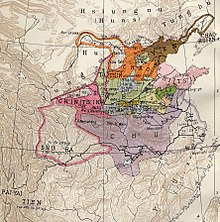Han (state)
The state of Han ( Chinese 韓國 / 韩国 , Pinyin Hánguó , occasionally to delimit it also Hann ) existed in China at the time of the Warring States with the capital Xinzheng (south of the Zhou capital Chengzhou, today's Luoyang ).
In the time of the spring and autumn annals, there was already a principality of Han near Hancheng , but this was much smaller and less powerful. It is said to have been established as a fief when the Zhou dynasty was established, but went under in the 8th century BC and became part of the territory of Jin . With the partition of Jin in the 4th century BC, the Jin feudal family of Han was able to establish this new state of Han. 403 BC The principality, which had existed for over 50 years at the royal court, was recognized together with Wei and Zhao . Han was the southernmost and smallest of the three Jin . Like Wei, located further to the north, Han was surrounded by stronger, potential aggressors ( Qin in the west and Chu in the south) and therefore initially tied closely to Wei. Later, in alternating alliances, it acted as a political buffer between these three powers. The state of Han reached its climax when the state around 375 BC. Annexed a large part of the neighbor Zheng and built his new capital there.
It was initially a principality whose rulers bore the title of Hou . With the progressive decline of the official ruling dynasty of the Zhou, however, the princes of Han proclaimed themselves from the 3rd century BC. To kings ( Wang ).
Han territory formed the passage from Qin State to the North China Plain. This made it a primary target for Qin's military operations. Han made many attempts to strengthen himself through reform, particularly through the legal scholar Shen Buhai . However, Han never surpassed its stronger neighbor Qin and was the first of the Warring States to be conquered by Qin.
The Qin invasion in 260 BC In the Shangdang headquarters led to one of the most costly battles of this time, the Battle of Changping .
There is no connection between the state of Hán and the later Hàn dynasty (漢朝).
Ruler of Han
| Posthumous title | Reign |
|---|---|
| Hóu Jing from Han | 409 BC BC to 395 BC Chr. |
| Hóu Lie from Han | 394 BC BC to 372 BC Chr. |
| Hóu Wen from Han | 371 BC BC to 369 BC Chr. |
| Hóu Ai from Han | 368 BC BC to 359 BC Chr. |
| Hóu Zhuang from Han | 358 BC BC to 333 BC Chr. |
| Hóu Zhao from Han | 332 BC BC to 326 BC Chr. |
| King Xuanhui of Han | 325 BC BC to 312 BC Chr. |
| King Xiang of Han | 311 BC BC to 296 BC Chr. |
| King Xi of Han | 295 BC BC to 273 BC Chr. |
| King Huanhui of Han | 272 BC BC to 239 BC Chr. |
| King An of Han | 238 BC BC to 230 BC Chr. |
| King Fei of Han | (unknown) |
literature
- Mark Edward Lewis: Warring states political history . In: Michael Loewe, Edward L. Shaughnessy, The Cambridge History of Ancient China: From the Origins of Civilization to 221 BC . Cambridge University Press, 1999. pp. 587-650, especially p. 596. Digitized
